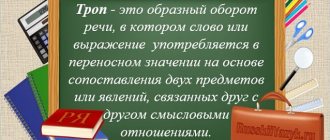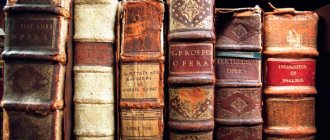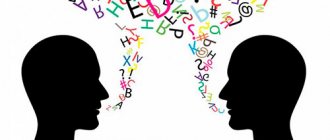Means of artistic expression (table)
Means of artistic expression are divided into lexical and syntactic.
Lexical means of expression
This is the lexical meaning of words and expressions. The lexical meaning of a word is the meaning, concept, meaning of a phenomenon/object.
For example, tropes (words are used figuratively).
| Figure of speech | Meaning | Example |
| Allegory | Depicting an abstract idea through a concrete image |
|
| Hyperbola | Obvious exaggeration or embellishment of reality |
|
| Irony | The opposite of what a person really thinks is conveyed, this is ridicule | Here, however, was the color of the capital, And know, and fashion samples, Faces you meet everywhere Necessary fools; (A.S. Pushkin) |
| Lexical repetition | Repeating words or entire phrases | Joints languish without medicine, Complications threaten the joints... (advertising "Chondroxid") |
| Litotes | Great understatement |
|
| Metaphor | Two terms are compared in an unusual sense |
|
| Metonymy | Replacing one term with another, if there is a logical connection between them |
|
| Personification | Animation of inanimate objects |
|
| Periphrase | Allegory; the name changes to some characteristics | using "blue planet" instead of "Earth" |
| Sarcasm | Unkind irony, caustic expression with humor | Nice perfume. How long did you marinate in it? |
| Synecdoche | Some small, specific concept is replaced by a more generalized one or vice versa |
|
| Comparison | A comparison of two concepts; conjunctions are often present: as, as if, etc. | eyes as yellow as amber |
| Epithet | An adjective, adverb, participle, or verb is used to describe something |
|
Syntactic means of expression
These are figures of speech, the way the author creates phrases, thereby placing emphasis and emotionally influencing the reader.
| Figure of speech | Meaning | Example |
| Anaphora (unity of principle) | Repetition at the beginning of lines, sentences, etc. | The city is lush, the city is poor... (A.S. Pushkin) |
| Antithesis | Contrasting words or concepts | Learning is light and ignorance is darkness |
| Gradation | Gradual reproduction of events or feelings along an increasing (or decreasing) trajectory | I came, I saw, I conquered |
| Nominative themes | Separating a noun in the nominative case |
|
| Polyunion (polysyndeton) | Homogeneous members are united by deliberate repetition of unions | There was typhus, and ice, and hunger, and a blockade (G. Shengeli) |
| Oxymoron | Paradox, putting words with opposite meanings together |
|
| Parcellation | Dividing a sentence into separate phrases or words to add special emphasis | The young artist <...> fell ill. And within a few days I lost my hearing. Forever. Almost completely (I. Andronikov) |
| Rhetorical question, exclamation, appeal | Used to intensify expressiveness |
|
| Syntactic parallelism | Repetition of the structure of a sentence or its individual parts (within a sentence) | I am a king, I am a slave, I am a worm, I am a god (G. R. Derzhavin) |
| Default | The author interrupts the hero’s words so that the reader himself understands what he wanted to say | But listen: if I have to To you... I own the dagger, I was born near the Caucasus (A.S. Pushkin) |
| Ellipsis | Exclusion of one of the members of the proposal | Tatiana in the forest; the bear is behind her; The snow is loose up to her knees; (A.S. Pushkin) |
| Epiphora | Repeating the end of a sentence (word or phrase) | The guests came ashore Tsar Saltan invites them to visit... (A.S. Pushkin) |
Stylistic techniques and means of expression
Stylistic devices and expressive means
Stylistic techniques and means of expression
In linguistics, the following terms are often used: expressive means of language, expressive means of language, stylistic means, stylistic devices. These terms are often used synonymously, but sometimes they have different meanings.
It is not easy to draw a clear line between expressive means of language and stylistic techniques of language, although there are still differences between them.
Under the expressive means of language
we will understand such morphological, syntactic and word-formation forms of language that serve to emotionally or logically strengthen speech. These forms of language have been worked out by social practice, understood from the point of view of their functional purpose and recorded in grammars and dictionaries. Their use is gradually being normalized. Rules for using such expressive means of language are developed.
What should be understood by stylistic device? Before answering this question, we will try to determine the characteristic features of this concept. Stylistic device
stands out and thereby contrasts with the means of expression by conscious literary processing of the linguistic fact.
This conscious literary processing of language facts, including those that we called expressive means of language, has its own history. Even A. A. Potebnya wrote: “Starting from the ancient Greeks and Romans and with a few exceptions to our time, the definition of a verbal figure in general (without distinguishing between a trope and a figure) (i.e., what is included in the concept of stylistic devices )
is not complete without contrasting simple speech, used in its own,
natural,
original meaning, and decorated, figurative speech.”1
Conscious processing of language facts was often understood as a deviation from commonly used norms of linguistic communication. So A. Ben writes: “A figure of speech is a deviation from the usual way of expressing itself in order to enhance the impression.”2
In this regard, it is interesting to quote the following statement by Vandries: “Artistic style is always a reaction against a common language; to a certain extent, this is an argot, a literary argot, which can have various varieties ... "
Sainsbury expresses a similar thought: “The true secret of style lies in breaking or neglecting the rules by which phrases, sentences and paragraphs are constructed.” (Our translation. I. G
)
It goes without saying that the essence of a stylistic device cannot be a deviation from commonly used norms, since in this case the stylistic device would actually be opposed to a linguistic norm. In fact, stylistic devices use the norm of the language, but in the process of using it they take the most characteristic features of this norm, condense it, generalize it and typify it. Consequently, a stylistic device is a generalized
1 Potebnya A. A. From notes on the theory of literature. Kharkov, 1905, p. 201.
2 Ben A. Stylistics and theory of oral and written speech M., 1886, p. 8
typified reproduction of neutral and expressive facts of language in various literary styles of speech. Let's explain this with examples.
There is a stylistic device known as maxims.
The essence of this technique is to reproduce the characteristic, typical features of a folk proverb, in particular its structural and semantic characteristics. A statement - a maxim has rhythm, rhyme, and sometimes alliteration; a maxim is figurative and epigrammatic, that is, it expresses some generalized thought in a condensed form.
Thus, the maxim and the proverb are correlated with each other as general and individual. This individual is based on the general, takes what is most characteristic of this general, and on this basis a certain stylistic device is created.
A stylistic device, being a generalization, typification, condensation of means that objectively exist in a language, is not a naturalistic reproduction of these means, but transforms them qualitatively. So, for example, improperly direct speech (see below) as a stylistic device is a generalization and typification of the characteristic features of inner speech. However, this technique qualitatively transforms inner speech. This latter, as is known, does not have a communicative function; improperly direct (depicted) speech has this function.
It is necessary to distinguish between the use of language facts (both neutral and expressive) for stylistic purposes and an already crystallized stylistic device. Not every stylistic use of linguistic means creates a stylistic device. So, for example, in the above examples from Norris’s novel, the author, in order to create the desired effect, repeats the words I and you. But this repetition, possible in the mouths of the novel’s heroes, only reproduces their emotional state.
In other words, in emotionally excited speech, the repetition of words, expressing a certain mental state of the speaker, is not intended to have any effect. The repetition of words in the author’s speech is not a consequence of such a mental state of the speaker and aims at a certain stylistic effect. This is a stylistic means of emotional
Stylistics deals with some special concepts that have nothing to do with a purely linguistic interpretation of linguistic categories. Expressive means are phonetic means, grammatical forms, morphological forms, means of word formation, lexical, phraseological and syntactic forms that function in the language to emotionally intensify the utterance. Expressive means are used to enhance the expressiveness of the statement; they are not associated with figurative meanings of the word. Expressive means = repetitions, parallelisms, antitheses, phonetic devices, use of archaisms, neologisms, etc. A stylistic device is the purposeful use of linguistic phenomena, including expressive means. Expressive means have a greater degree of predictability compared to stylistic devices. Stylistics deals with expressive means and stylistic devices, their nature, functions, classification and possible interpretation.
Classification of expressive means (Urve Lehtsaalu):
lexical group (poetic words, archaisms, dialectisms, neologisms) phonetic group (rhythm, euphony (euphony) grammatical group (inversion, elliptical sentences, repetition, exclamation)
Epithet
- definition of a word expressing the author's perception: silvery laugh a thrilling tale an exciting/exciting story a sharp smile The epithet always has an emotional connotation. It characterizes an object in a certain artistic way and reveals its features. a wooden table (wooden table) - only a description, expressed in an indication of the material from which the table is made; a penetrating look (penetrating look) - epithet.
Comparison (simile)
- a means of likening one object to another according to some characteristic in order to establish similarities or differences between them. The boy seems to be as clever as his mother. The boy seems to be as smart as his mother.
Irony
- a stylistic device where the content of a statement carries a meaning that is different from the direct meaning of this statement. The main purpose of irony is to evoke a humorous attitude in the reader towards the facts and phenomena described. She turned with the sweet smile of an alligator. She turned around with a sweet alligator smile. But irony is not always funny; it can be cruel and offensive. How clever you are! You're so clever! (Implies the opposite meaning - stupid.)
Hyperbole
- exaggeration aimed at enhancing the meaning and emotionality of a statement. I have told you it a thousand times. I've told you this a thousand times.
Litotes/Understatement ( litotes / understatement )
- understatement of the size or significance of an object. Litotes is the opposite of hyperbole. a cat-sized horse Her face isn't a bad one. She doesn't have a bad face (instead of "good" or "beautiful").
Periphrase/Paraphrase/Periphrase (periphrasis)
- an indirect expression of one concept with the help of another, its mention by not direct naming, but by description. The big man upstairs hears your prayers. The big man above hears your prayers (by “big man” we mean God).
Euphemism
- a neutral expressive device used to replace uncultured and rude words in speech with softer ones. toilet → lavatory/loo toilet → restroom
Oxymoron
- creating a contradiction by combining words that have opposite meanings. The suffering was sweet! The suffering was sweet!
Zeugma
- omitting repeated words in similar syntactic constructions to achieve a humorous effect. She lost her bag and mind. She lost her bag and her mind.
Metaphor
— transfer of the name and properties of one object to another based on their similarity. floods of tears a storm of indignation a shadow of a smile pancake/ball → the sun pancake/ball → sun
Metonymy
- renaming; replacing one word with another. Note: Metonymy must be distinguished from metaphor. Metonymy is based on contiguity, on the association of objects. Metaphor is based on similarity. Examples of metonymy: The hall applauded. The hall welcomed (by “hall” we mean not the room, but the spectators in the hall). The bucket has spilled. The bucket splashed (not the bucket itself, but the water in it).
Synecdoche
- a special case of metonymy; naming a whole through its part and vice versa. The buyer chooses the quality products. The buyer selects quality goods (by “buyer” we mean all buyers in general).
Antonomasia (antonomasia)
- a type of metonymy. Instead of a proper name, a descriptive expression is used. The Iron Lady The Iron Lady Casanova Casanova Mr. All-Know
Inversion
- a complete or partial change in the direct order of words in a sentence. Inversion imposes logical tension and creates emotional coloring. Rude am I in my speech. I am rude in my speech.
Repetition
- an expressive means used by the speaker in a state of emotional tension, stress. Expressed in the repetition of semantic words. Stop! Don't tell me! I don't want to hear this! I don't want to hear what you've come for. Stop it! Do not tell me! I don't want to hear this! I don't want to hear what you came back for.
Anadiplosis
- using the last words of the previous sentence as the beginning words of the next one. I was climbing the tower and the stairs were trembling. And the stairs were trembling under my feet. I climbed the tower, and the steps shook. And the steps shook under my feet.
Epiphora
- using the same word or group of words at the end of each of several sentences. Strength is given to me by fate. Luck is given to me by fate. And failures are given by fate. Everything in this world is given by fate. Strength was given to me by fate. Luck was given to me by fate. And failure was given to me by fate. Everything in the world is decided by fate.
Anaphora/Unity of Birth (anaphora)
- repetition of sounds, words or groups of words at the beginning of each speech passage. What's the hammer? What the chain? Whose hammer was it, whose chains, In what furnace was thy brain? To seal your dreams? What the anvil? What dread grasp Who took up your swift swing, Dare its deadly terrors clasp? Got mortal fear? (“The Tiger” by William Blake; Translation by Balmont)
Polysyndeton/Multi-Union (polysyndeton)
- a deliberate increase in the number of conjunctions in a sentence, usually between homogeneous members. This stylistic device emphasizes the significance of each word and enhances the expressiveness of speech. I will either go to the party or study up or watch TV or sleep. I will either go to a party or study for an exam or watch TV or go to bed.
Antithesis/contraposition
- a comparison of images and concepts that are opposite in meaning or opposite emotions, feelings and experiences of the hero or author. Youth is lovely, age is lonely, youth is fiery, age is frosty. Youth is beautiful, old age is lonely, youth is fiery, old age is frosty. Important: Antithesis and antithesis are two different concepts, but in English they are denoted by the same word antithesis [æn't???s?s]. A thesis is a judgment put forward by a person, which he proves in some reasoning, and an antithesis is a judgment opposite to the thesis.
Ellipsis
- deliberate omission of words that do not affect the meaning of the statement. Some people go to priests; others to poetry; I to my friends. Some people go to priests, others to poetry, I go to friends.
Aposiopesis (aposiopesis])
- a sudden stop in speech, making it unfinished; interrupting one sentence and starting a new one. I if only could I… But now is not the time to tell it. If only I could, I... But now is not the time to talk about it (instead of an ellipsis in English, a dash can be used. For more information about punctuation, see the material “Punctuation Marks”).
Rhetoric/rhetorical questions
- a question that does not require an answer, since it is already known in advance. A rhetorical question is used to enhance the meaning of a statement, to give it greater significance. Have you just said something? Did you say something? (Like a question asked by a person who did not hear the words of another. This question is asked not in order to find out whether the person said something at all or not, since this is already known, but in order to find out exactly what he said.
Pun/Wordplay (pun)
- jokes and riddles containing puns. What is the difference between a schoolmaster and an engine-driver? (One trains the mind and the other minds the train.) What is the difference between a teacher and a driver? (One guides our minds, the other knows how to drive a train).
Interjection
- a word that serves to express feelings, sensations, mental states, etc., but does not name them. O! Oh! Ah! ABOUT! Oh! Oh! Oh! Aha! (Aha!) Pooh! Ugh! Ugh! ugh! Gosh! Damn it! Oh shit! Hush! Quiet! Shh! Tsits! Fine! Fine! Yah! Yah? Gracious Me! Gracious! Fathers! Christ! Jesus! Jesus Christ! Good gracious! Goodness gracious! Good heavens! Oh my god! (Lord! My God!
Cliche/Stamp (cliche)
- an expression that has become banal and hackneyed. Live and learn. Live and learn.
Proverbs
and sayings
. _ A shut mouth catches no flies. Even a fly cannot fly into a closed mouth.
Idiom/set phrase
- a phrase whose meaning is not determined by the meaning of its constituent words taken individually. Due to the fact that the idiom cannot be translated literally (the meaning is lost), difficulties in translation and understanding often arise. On the other hand, such phraseological units give the language a bright emotional coloring. No matter Cloud up Frown
Means of expression in music
The main means of expressiveness of musical composers are:
- mode (usually major or minor);
- dynamics (volume);
- meter, rhythm, tempo (rhythmic measure);
- registers (range of a musical instrument);
- timbre (color or character of sound);
- strokes (separate or connected: staccato, legato, non legato);
- melody (the main musical idea of the composer);
- harmony (learning chords);
- texture (design of polyphony).
Lexical means
This is a set of artistic words and expressions that give the author’s literary style or colloquial speech emotional expressiveness in a figurative sense.
Tropes are words and figures of speech used in an allegorical meaning. They are used by authors to enhance the image, to produce an effect on the reader or listener, transferring the attribute of one object to another.
Main types of trails:
| · Metaphor; · Metonymy; · Synecdoche; · Epithet; · Hyperbole; · Dysphemism; · Pun; · Litota; | · Paraphrase; · Allegory; · Pathos; · Personification; · Sarcasm; · Irony; · Euphemism. |
Means of graphic expression
Artists are already using their own techniques:
- texture (paper can be smooth or embossed);
- background (color and tone of the surface);
- line (figurative, calligraphic, geometric);
- stroke (short lines);
- rhythm (different sizes of objects and distances between them);
- spot (square, circle, etc.);
- chiaroscuro and tone (the relationship between light, shadows, textures, shapes, etc.).
Find out more about:
- Allegory;
- Examples of metaphor;
- Lexical repetition;
- Metonymy;
- Metaphor;
- Graduation;
- Sarcasm;
- Synecdoche;
- Irony;
- Hyperbole;
- Syntactic parallelism;
- Antithesis;
- Periphrase;
- Epithet;
- Anaphora;
- Oxymoron.
How to make your speech beautiful and attractive!
Our speech is not only a tool for communication and transmission of information, but also our individual feature...
Each person’s speech is unique and has a number of individual characteristics. The voice is as unique as fingerprints or the structure of the retina. A person's character is judged by his voice. It is known that the overall impression of a person depends 55% on facial expressions, 38% on voice, and only 7% on what this person says.
Only competent, clear speech is capable of conveying correct information and being understandable to others.
The secret of your success is the art of speaking!
From early childhood to old age, human life is connected with speech. Rough thinking - rude speech, cultural thinking - cultural speech. Since thought always precedes the word, without developing thinking we cannot develop our speech. In ancient times there was a science of rhetoric, the founder of which was the great Greek philosopher Aristotle. He pointed out that the mastery of a performance is determined by three components. The first of these was clarity of thought, and it appears only with the knowledge that a person receives along with experience. Only with the development of clarity of thinking will speech gradually develop. For our speech to be understandable, it must reflect a developed mind, thoughtfulness of thought, literacy, and for it to be also pleasant, it must be expressive and emotional. Through words, a person can touch the ancient thoughts of his ancestors, gain experience and knowledge, and send a message to his great-grandchildren in the future.
Properties of speech:
- Content - characterized by the volume of thoughts expressed in it, is ensured by the preparedness of the speaker.
- Comprehensibility is determined mainly by the volume of knowledge of listeners and is ensured by selective selection of material available to listeners.
- Expressiveness is associated with emotional richness and is ensured by intonation, emphasis, and pauses.
- Effectiveness is determined by the influence on thoughts, feelings, behavior, and is ensured by taking into account the individual characteristics of the listeners.
A person who speaks competently makes a favorable impression, he more often achieves his goal, he is more successful in his professional activities, and it is easier for him to adapt to any life situation.
Correct speech has an almost magical effect. I want to listen to her and listen to her; and from another - close your ears and run away.
Mastery of the art of speaking beautifully and competently, unfortunately, is becoming less and less common.
People who think masterpieces sometimes do not know how to express themselves as clearly in words. Many find it difficult to express their thoughts, feelings, or retell anything interesting they have read, seen, or experienced.
But behind the artless speech of such people sometimes hides a magnificent intellect and an interesting personality. But it takes time to recognize this. And time is something that we constantly lack.
From here there is only one way - you need and can train your speech. After all, the ability to speak beautifully is not a natural gift, but an acquired skill that can be brought to perfection. Even if you do not intend to become a professional speaker, the ability to speak beautifully and use speech correctly will be extremely useful both in work and in everyday personal life.
Following some rules can significantly improve the quality of your speech.
First, read more. Newspapers, magazines, high-quality fiction. In this sense, our domestic classics, which we all studied during our school years (or didn’t study, which is sad), are ideal. Read or re-read the classics! And out loud, without rushing. Such reading will have a colossal effect. It will teach you how to correctly form words into sentences and increase your vocabulary.
Secondly, exclude parasitic words from your speech: “well”, “in general”, “as if”, “well this”, “damn”, etc. Try, if possible, to remain outwardly calm, do not wave your arms, and do not reflect strong emotions in your speech. This will only increase the level of trust in you and give you authority. Speak in simple phrases, take your time.
Thirdly, watch the pace of your speech. It shouldn't be monotonous. Pause to highlight the main points of the conversation. It should be appropriate and not tight.
Fourthly, use comparisons, metaphors, figurative expressions, sayings, and finally, in conversation. This will enliven the speech and make it more interesting. And, of course, a win-win option is humor. Appropriate self-irony and jokes will add shine to your speech. After all, words are only means for transmitting information, and the way you compose and pronounce them will either sink into your soul or not.
Fifth, speak, practice your speech as much as possible. This is easy to do if you have a wide social circle. If it is not there, then a TV or radio will help. Choose the TV presenter you like best and try to imitate him. Repeat phrases out loud (!) after him, also copying his voice intonations. It's not easy, but after some time you will certainly see progress. In addition to developing melodic speech, you will expand your vocabulary.
There is another fun, and only difficult exercise at first. Choose a simple household item, such as a floor lamp or slippers. Set a time limit for yourself in which you will talk about this subject in beautiful literary language. At first it will be difficult to talk for 5 minutes about some banal floor lamp. But it will get easier with every workout. By increasing the time limit and complicating the topic, you will soon overcome uncertainty, timidity in front of words, and inability to choose them. As a result, you will be able to enthusiastically talk about your slippers for an hour without repeating yourself. It is better to do this in a group or with your family, turning the training into a kind of game. In turn, everyone becomes both a performer and a listener.
Another exercise from the masters of speech to develop melody.
We say out loud:
My voice is soft, soft
Singing, singing,
Velvet, velvet.
I hope these recommendations will help you learn to speak beautifully, expressively and clearly! And you will definitely be noticed and not ignored!
Dare, try, play!
Rhetorical questions and exclamations
The texts of some works use isolated questions that do not require responses. Such questions are called rhetorical. They do not imply answers and express the position of the author. Rhetorical questions are often used by writers to highlight the main issues of a work. Examples:
And is it really worth worrying about something that can’t be changed?
Why does everyone dream of the impossible, missing out on their quiet and moderate happiness?
When will people finally become kinder? When will they start treating others with understanding and respect?
Rhetorical exclamations also have an accentuating and emphasizing meaning. With the help of exclamatory sentences, the emotional and expressive side of the content of the text is expressed. For example:
How can you forget about honor and decency in the pursuit of material wealth!
How far greed and thirst for profit can lead a person!
Modern views
You may be interested in: Tunisia: description of the country, its features
Lexical and syntactic means of expression are numerous and varied. There is no clear classification, but they are conditionally divided into three groups: phonics, vocabulary and figures. The first includes sound features necessary to give expressiveness to the text. Most often, sound repetition is used in the form of assonance, alliteration, and onomatopoeia.
The vocabulary contains both neutral words, which denote concepts without evaluation by the narrator, and those that convey the author’s direct attitude. Resources are divided into two groups: basic and special. The first includes synonyms, antonyms, homonyms, dialectisms, jargon, archaisms. More and more often you can find neologisms - words that have not yet become familiar. Their number is increasing due to the development of information technologies for the transfer of objects and concepts.
Among the special syntactic means of expressiveness are those that give the text meaning, persuasiveness, and special brightness. These include epithets, comparisons, allegory, metaphor, metonymy, symbol, anaphora, rhetorical interrogation.
Anaphora
Anaphora is unity of command. Every line of poetry or every sentence in prose begins with the same word or group of words. This is a very common technique that is widely used in literature, especially in poetry.
There are many examples of the use of anaphora. Let's say, in this children's song based on the poems of the poet Lev Oshanin:
May there always be sun, May there always be sky,
May there always be a mother
May it always be me.
In this example, a group of words is repeated. In addition to anaphora, the author uses syntactic parallelism (several lines in a row have the same syntactic structure).
Often in one work or even a passage, not one means of expression is used, but several.









